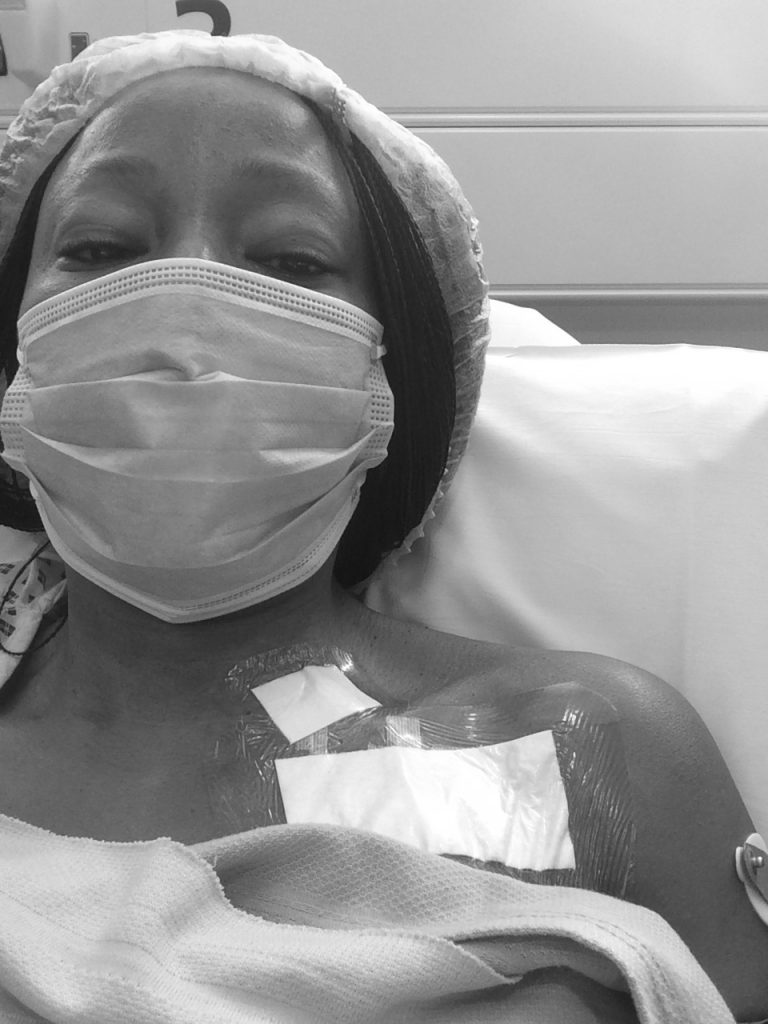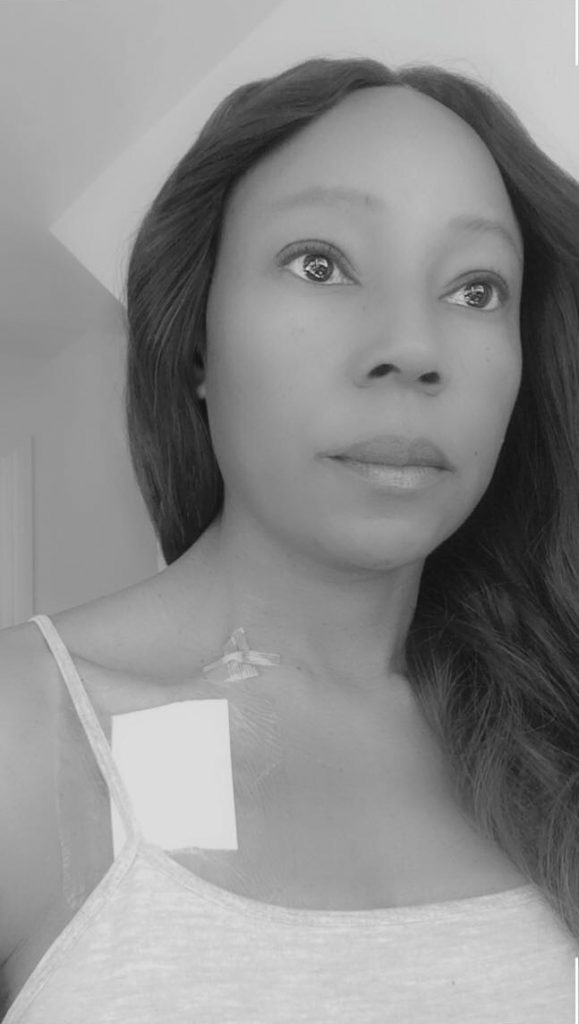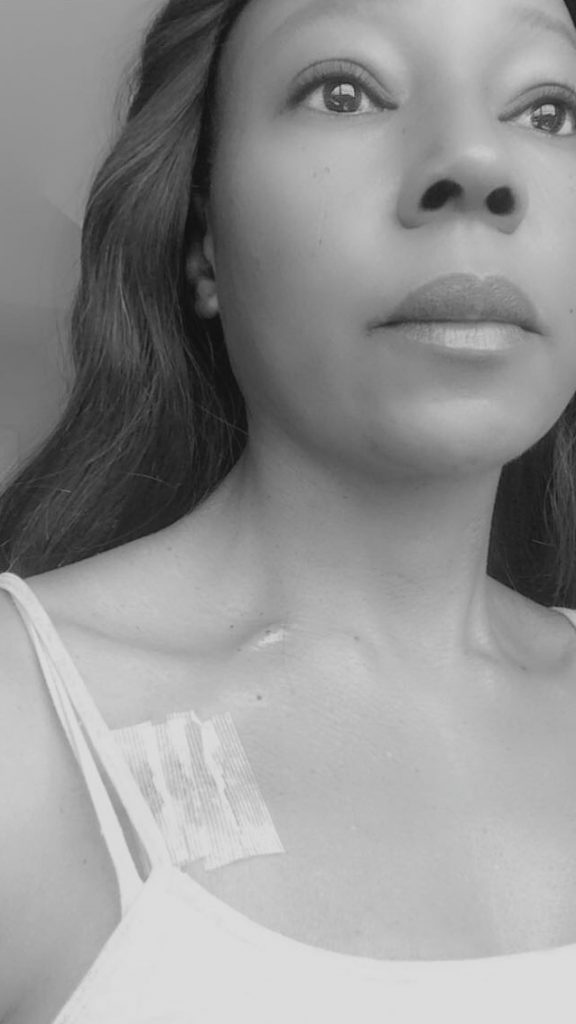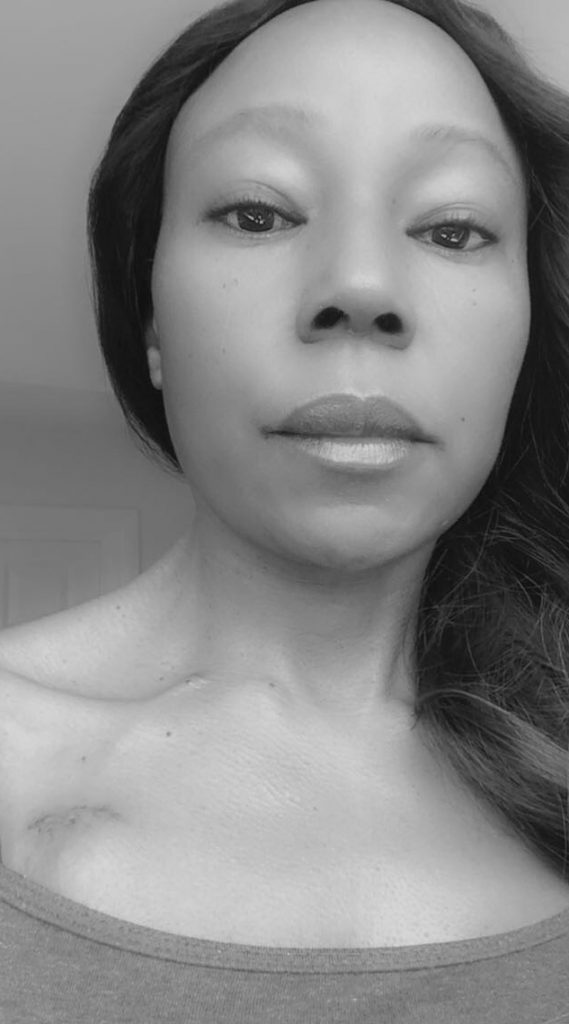..."it's purely bad luck Kemi."...
2. Chemo Prep The Second Time
- 1. My Most Recent Scare
- 2. Chemo Prep The Second Time
- 3. Chemotherapy The Second Time Begins…
- 4. Chemo Side Effect The Second Time
- 5. What I’m Currently Eating
- 6. Port-a-Cath My Saving Grace
- 7. My Lockdown Support Team
- 8. ENT Surgery & Prep
- 9. Chemotherapy The Third Time Begins…
- 10. Chemo Side-Effects & Changes, The Third Time.
- 11. Journey Towards A New Recovery
Today Is Monday 21st September 2020 & My Return to Guy’s Medical Oncology Breast Clinic: I am here to see the Oncology Breast Team and discuss my options on a Metastatic Lymph Node, on The Right Supra-Clavicular Isolated Breast Metastases discovery, which is a by-product of having had breast cancer almost five years ago.
I walked into room 32 as instructed by the electronic notification board. There were two people in the room. The Medical Oncologist Dr Hartmut Kristeleit whom I have met before almost four years ago before the first rounds of chemotherapy began and Specialist Onco Nurse Anna who is new to me.
Dr Hartmut Kristeleit is an investigator on numerous clinical trials for breast cancer and chairs the oncology clinical trials committee at Guy’s and St Thomas’. He also has a keen research interest in the role of novel therapies for cancers.
He expressed his sadness at seeing me back and quickly moved on to the matter of discussing my options. The Onco team had previously reviewed all my test results and made their recommendations.
He confirmed their findings again as a Metastatic Lymph Node on The Right Supra-clavicular Isolated Breast Metastases.
Dr Kristeleit went through my Position Emission Tomography AKA (PET) scan results again with me showing that there was only that one lymph node showing any indication of any disease in my body. He then began relaying my options and the best way forward.
Recommendations: – I will be receiving chemotherapy. The combination this time around will be a drug called Paclitaxel, Trastuzumab and Pertuzumab. After treatment, there will be surgery to remove the lymph node.
Paclitaxel: This is used to treat ovarian, breast, and non-small cell lung cancer. Paclitaxel can be given on its own or in a combination with other chemotherapy drugs.
Trastuzumab and Pertuzumab: They are targeted therapies used to treat breast cancer and are usually given with chemotherapy. Trastuzumab and Pertuzumab both work by targeting specific proteins (receptors).
Some cancers have too much of a protein called human epidermal growth factor receptor 2 (HER2) on the surface of their cells. These are called HER2 positive cancers. The extra HER2 receptors stimulate the cancer cells to divide and grow.
Trastuzumab and Pertuzumab work by locking into HER2 proteins. Each drug locks on to a different part of the protein. This blocks the receptors and stops the cells from dividing and growing.
Trastuzumab and Pertuzumab only work in people who have cancer with high levels of HER2 such as myself.
Surgery: This will happen last because while I’m having treatment the Onco team would like to monitor how cancer inside the lymph node is reacting to chemotherapy.
Before signing the consent forms I asked Dr Kristeleit why this happened after all the treatment I had undergone and he said: “it’s purely bad luck Kemi.” He went through the side effects of all the drugs and again reassured me that the effects of this combination of drugs are not going to be as harsh on my body as the first time around.
Duration: Paclitaxel will be administered once every week between 12 – 18 rounds. Trastuzumab and Pertuzumab will be administered once every 3 weeks for about 18 rounds. As the cancer is being closely monitored the sessions will be reviewed and could be less than 18 sessions each.
Today is Wednesday 23rd September: I decided to inform my three sisters on the past month plus. During our WhatsApp group call, I told them everything and I was able to answer their questions. They were very sad but happy an action plan had already been put into place. I promised to keep them posted with appointment dates. As always they were all extremely supportive.
Today is Thursday 24th September: In preparation for chemotherapy the second time and during COVID-19, I had an early appointment at the Blood Centre then a COVID swab test at Guy’s Hospital.
Then to St. Thomas’ Hospital for an echocardiogram. This is an ultrasound scan of the heart. The oncologists need to ensure that my heart is able to endure the treatment ahead. My heart is in excellent shape, I was told.
Today is Friday 25th September: If you have been following my journey, you would know that I’m blessed with two (2) mums. My Nigerian mum and my UK mum. I called my Nigerian mum and informed her of my current situation. She was overwhelmed with sadness so I tried my best to put her at ease.
There are three more family members that needed to be informed before I started receiving chemotherapy. My eldest brother and aunty (his wife) in Nigeria and my UK mum.
Today is Monday 28th September: A call came through from Guy’s Head and Neck department confirming an appointment for Wednesday 30th September at 10 AM which I gladly accepted. This appointment is a very important one as they will be taking a close look at the positioning of the lymph node which is to be removed once chemo was completed.
Today is Wednesday 30th September: My appointment with the ENT (Head, Neck & Throat) department at Guy’s Hospital was this morning at 10 AM. I was called in by Mr Alex Rovira who specialises in head and neck pathology with a particular interest in head and neck cancer including laryngeal cancer, salivary gland cancer, and transoral robotic surgery.
He brought up my PET scan and again went through it with me. He informed me my scan had been discussed during their team meeting and it was operable with very low risks of permanent damage.
He stated every surgery had its risks and that mine is minimal. He gave me details on how the procedure would be performed and the worst-case scenario.
Mr Alex Rovira was ready to book me in for the next Thursday so I informed him the oncology team would like to monitor the reaction of the node to chemotherapy first. He explained the pros and cons of shrinking the node before surgery but either way he will do his best to remove the node and any trace it leaves behind. Looking at Dr Kristeleit’s notes again he confirmed the removal of the lymph node would be after my fourth (4) round of chemotherapy.
I felt relieved that the lymph node can be taken out and that I had an opportunity to talk with and put my questions to Mr Rovira who will be performing the procedure.
Today is Monday 5th October: I attended a COVID Swab appointment at St. Thomas’ hospital in preparation for Thursday to have a Port-a-Cath insertion procedure.
The COVID Swab process took less than five minutes. After checking my details, a nurse handed me a little kit containing a long swap stick, a little tube and two see-through plastic sleeves. I was directed into a little cubicle where I swabbed the back of my throat first then both nostrils. I placed the stick into the little tube provided and closed the lid. The little pack was handed back to the nurse and I was free to go.
Today is Friday 9th October: I arrived at the Interventional Radiology department early. Was assigned to a bed, given a gown, a pair of socks, and some blankets. The signing of consent forms and confirmation of details was done first. The attending physician came to discuss the process and answer any questions.
Then came the part I have been dreading which is the blood work. Before my procedure can be done, my white blood (which helps fight infection) cell count needed to be rechecked because the previous test indicated my white blood count was low.
The nurse assigned to me saw how small my veins were so decided to call a doctor to try so that I’m not pricked too many times. Dr Tom Gordon was a total delight and on the fourth attempt we got blood and he fixed a cannula for my procedure.
After a long wait, the blood work came back and the white blood count was still low. After talking with my oncologist Dr Kristeleit, he instructed the procedure should commence and I was to be given a shot of antibiotic. During chemo, I was going to be closely monitored.
What is a Port-a-cath?: It’s a small medical device that is installed beneath the skin. A soft, thin hollow plastic tube is known as a catheter. The tube is tunnelled under the skin with the tip sitting just outside the heart. A port or disc is inserted into the chest and attached to the tube. These small, flexible tubes are placed in large veins for people who require frequent access to the bloodstream during treatment such as myself.
The veins on my left arm are exhausted from the constant needle puncture which started almost four years ago. This is a saving grace for me as the port can be left in for a long period of time.
I walked into the theatre and it was freezing cold. There was a huge revolving ex-ray machine, screens, and monitoring devices. Lots of drawers and stools. I was instructed to lay on the procedure table then covered up. Think there were four people in the room, two doctors and two nurses. They all introduced themselves but no one’s name stuck apart from Dr Tom Gordon. I was covered up and the area prepped for the insertion.
Shortly after the introductions, there was a lot of talking amongst the doctors and nurses, lots of movements and surgical types of equipment being brought out of the draws and placed next to the doctors. The area was made numb and the process began. Every now and then the nurses and doctors would ask how I was doing?
I would say about forty-five minutes later all was done and I was told it had gone well. I knew Dr Gordon had done a good job on the procedure because I listened very attentively as he and his attending doctor worked. The senior doctor was impressed with the technique Dr Gordon used and she told him so several times.
I heard the nurses checking all the tools used were still accounted for. The protective clothing was taken off me and I was wheeled back into the recovery room.

Back in recovery, I was offered something to eat and drink then monitored for two hours with continual vitals monitoring. Dr Gordon came back for a quick chat then discharged me. I was given some plasters to change the dressing with instructions. My close friend Jane had already arrived so I was discharged to her.
Today is Monday 12th October: Four days since the port-a-cath insertion procedure. I’m home taking it easy while recovering. The area is very sore especially around the throat but all in all, there have been no complications. I changed the smaller dressing yesterday without any problems. The bigger dressing will be changed in a week and removed in two weeks’ time.
Today is Thursday 15th October: It’s exactly one week since I had the port-a-cath procedure. I’m recovering well with no complications. I’m still extremely tender and still moving around very slowly.
Both of the dressings on the procedure section were removed this morning. The smaller puncture is now without a dressing while the bigger puncture and where the port is will be covered up for another week. I had my first proper full shower this morning and it felt great.

Today is Saturday 17th October: I went to see my UK mum and decided to tell her as I wasn’t sure when I would be seeing her again due to COVID-19 and all the new restrictions being imposed all over the UK.
She cried, screamed, and asked questions. I told her as much as I could and encouraged her not to cry or be sad. My diagnosis was not good but my prognosis was very optimistic. The next few months are going to be a journey but all will be fine.
Today is Thursday 22nd October: It’s exactly two weeks that I had the port-a-cath procedure. I’m still recovering well with no complications. Not as tender nor as sore and moving around with more ease and planning on my first early morning run tomorrow morning.
Both of the dressings on the procedure section have now been removed. The smaller puncture has healed very well. The bigger puncture and site of the port-a-cath still had surgical tapes on it. This will fall off in a day or two.

Today is Saturday 24th October: I woke up early and went for my first early morning run in over two weeks since the port-a-cath was inserted. I was very careful with each step and my run took a little longer than normal and ran my normal route without stopping. It felt great at the out again.
Three weeks into getting the Port-a-cath inserted, both dressing and surgical tapes peeled off. I would say the insertion site is healing slowly and very well.

Today is Thursday 29th October: I Had an appointment at Guy’s hospital for some blood work in preparation for chemo which starts next week. My port would be accessed for the first time. Not knowing how this works made me very anxious. The port nurse assigned to me explained the process and assured me I was in good hands.
The entrance to the port will be sterilized, a tiny needle will be inserted into a certain section of the port, I will feel a little prick and that would be it, the blood would be drawn and the port-a-cath would be flushed to prevent any infection and a tiny plaster would be placed on the spot.
That was exactly what happened. It was such a quick and painless process that I wondered why the same option wasn’t offered to me the first time around almost four years ago. The constant needle punctures had been a nightmare because I have extremely tiny veins so every time I had bloodwork there were sometimes three to four attempts before a suitable vein was obtained. Sometimes those attempts were excruciatingly painful. Thank God for the port-a-cath invention.
- 1. My Most Recent Scare
- 2. Chemo Prep The Second Time
- 3. Chemotherapy The Second Time Begins…
- 4. Chemo Side Effect The Second Time
- 5. What I’m Currently Eating
- 6. Port-a-Cath My Saving Grace
- 7. My Lockdown Support Team
- 8. ENT Surgery & Prep
- 9. Chemotherapy The Third Time Begins…
- 10. Chemo Side-Effects & Changes, The Third Time.
- 11. Journey Towards A New Recovery
